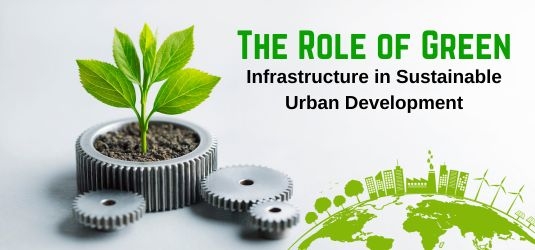
Green Infrastructure in Urban Development is transforming how we design cities to preserve nature and reduce pollution. As cities expand, the need for eco-friendly urban planning has never been more urgent. By blending natural solutions with urban growth, we can create healthier, more resilient communities for future generations.
In this blog, we will explore what Green Infrastructure in Urban Development means, highlight its key environmental benefits, and examine the challenges cities face when adopting these solutions.
What is Green Infrastructure in Urban Development?
Green Infrastructure in Urban Development refers to a strategically planned network of natural and semi-natural spaces within cities. These include parks, green roofs, rain gardens, wetlands, and urban forests. Unlike traditional “grey” infrastructure, green infrastructure uses natural processes to deliver ecosystem services such as water purification, air quality improvement, and climate regulation.
This approach not only supports biodiversity but also enhances the quality of life for urban residents by providing recreational spaces and promoting community well-being. By weaving green corridors and blue spaces like rivers into the urban fabric, cities can become more resilient to climate change. Consequently, this will reduce the urban heat island effect and manage stormwater more effectively.
Benefits of Green Infrastructure in Urban Development
Adopting Green Infrastructure in Urban Development delivers a wide range of environmental, social, and economic benefits. Here are some advantages that make green infrastructure a cornerstone of sustainable urban planning:
- Reduces air pollution by filtering contaminants and producing oxygen through vegetation and urban forests.
- Mitigates urban heat islands by providing shade and regulating temperatures, lowering energy consumption for cooling.
- Manages stormwater naturally by absorbing and filtering rainwater, reducing flood risks, and preventing water pollution.
- Enhances biodiversity by creating habitats for various species, supporting urban wildlife, and maintaining ecological balance.
- Improves mental and physical health by offering accessible green spaces for recreation, reducing stress, and promoting community interaction.
These benefits highlight why eco-friendly infrastructure in urban cities is vital for modern cities facing environmental and social challenges.
Challenges of Green Infrastructure in Urban Development
Despite its many benefits, implementing Green Infrastructure in Urban Development faces several challenges. Overcoming these barriers is crucial for maximizing its potential:
- Limited urban space makes it difficult to allocate land for new green projects in densely built cities.
- High initial investment costs can deter municipalities from prioritizing green infrastructure over traditional solutions.
- Maintenance and management require ongoing resources and skilled personnel to ensure long-term effectiveness.
- Lack of public awareness can result in insufficient community support and engagement for green initiatives.
- Policy and regulatory hurdles may slow down the integration of green infrastructure into urban planning frameworks.
Addressing these challenges is essential for the successful adoption of Green Infrastructure in Urban Development.
Final Thoughts
Green Infrastructure in Urban Development is a powerful tool for creating sustainable, resilient, and healthy cities. By prioritizing nature-based solutions, urban planners can reduce pollution, preserve biodiversity, and enhance the well-being of residents. The future of urban development lies in embracing green infrastructure, fostering collaboration among policymakers, architects, and communities.
Join Green Circle Environment in advocating for greener cities. Support local green projects, stay informed, and help shape a more sustainable urban future.








